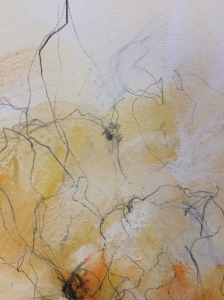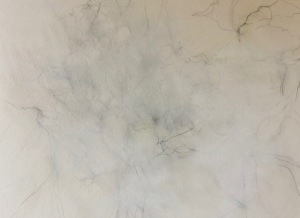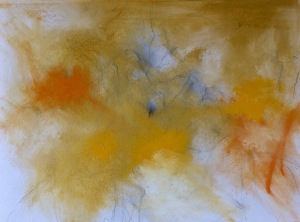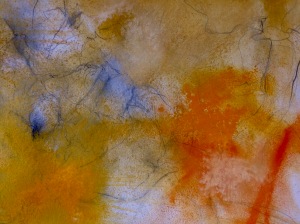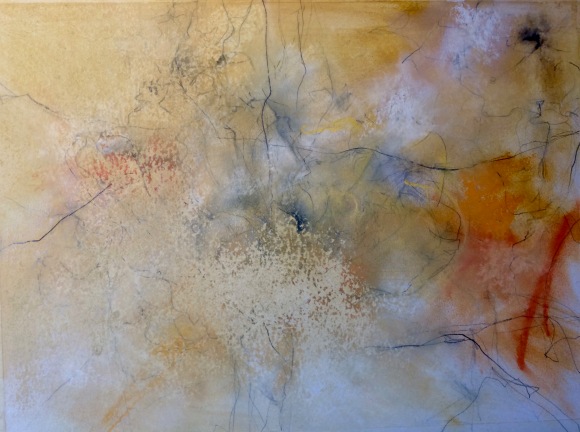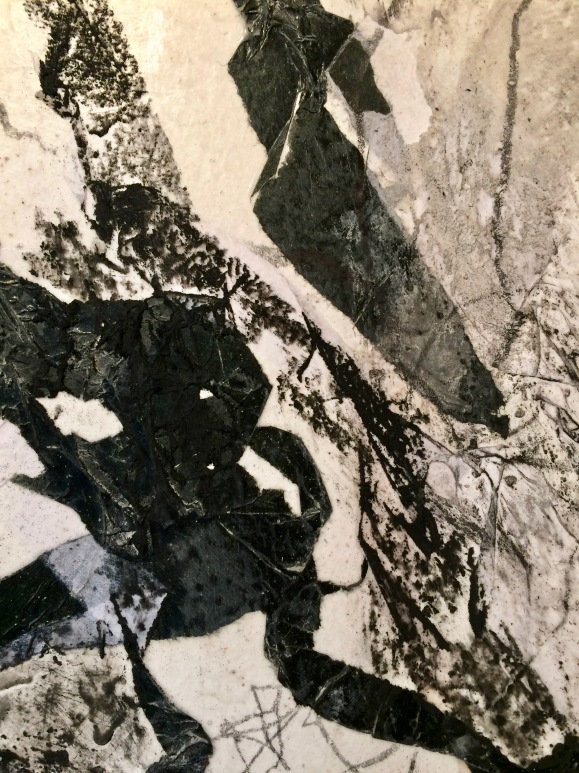TUTOR REPORT
PART 6 and CRITICAL ESSAY
Overall Comments
You have delved into an abstraction of the concept of abstraction in your PP to make work, which is enticing through qualities of line and notions of drawing outside of a drawing. There are complex issues of drawing as a language which has been explored intensely. Your work could be infinite as your research into abstraction suggests. The work also suggests an ephemeral quality, which has echoes your journey into and through this unit.
Overall comments for the critical essay are below.
Feedback on assignment
Demonstration of technical and Visual Skills, Quality of Outcome, Demonstration of Creativity
Parallel Project-
First study- I am glad you found the distinction of abstraction and abstracting work useful at this stage and this has led to a new line of enquiry in your work. This first piece is almost a question visualised because there are no definite forms or borders. It would have been dangerous to do this because your work contains more movement and fluidity than the typical abstract art you have been referring to. The fading and loss of definite lines reinforce your notions of abstract thinking. It is almost a cartographic design of your thinking.
Second and third pieces- these pieces are a line of thought because that thought has become more solid with a definite bold line. Still explorative in questioning and application. I have written this before I read your explanation and hope it confirms your thinking as it echoes your intentions. The bold lines are not as harmonious or as fluid as the previous piece but perhaps this is due to a sporadic thought trial?
Final piece- This does feel like a conclusive piece in your journey as it is solid but incorporates your successful elements of mix media, the ephemera and the found and lost. As you say, there has to be an end point…for now. You have concluded the work with strong geometric lines in contrast to the freer lines of thought and this gives a dichotomy and tension between the abstraction and the once representational.
Experience, thought and idea– it seems like his parallel project are chapters of your journey in this unit from gathering your experiences, which then becomes thought about as you abstract ideas from these experiences which finally become the idea- something more concrete to represent this experience.
Sketchbooks
Demonstration of technical and Visual Skills, Demonstration of Creativity
The Abstraction Sketchbook is an explorative route, which was needed for you to investigate the wider concepts of line (memory, place and time). But also think about the contextual issues within contemporary art, such as, the ‘post-truth landscape.’ You shifted away from seeing too much in your work, such as figures and representations and remained objective in your discoveries. It seems like you allowed yourself to be the continuous and sometimes, unpredictable lines in your PP. A personal voive has been developed clearly.
Research
Context, reflective thinking, critical thinking, analysis
Your research surrounding your work has aided you in finding a voice through your practical work. You have meaningful artists and sources for your critical essay but they could be succinct more by linking them to each other. Your use of quotes supports your ideas and you have referenced accordingly. Also you have a solid bibliography. Critical analysis is mentioned in the next section but a personal voice is coming though in a complex idea. Sometimes this complexity could be simplified for the reader.
Learning Logs or Blogs/Critical essays
Context, reflective thinking, critical thinking, analysis
Critical essay-START
“REPRESENTATION OR ABSTRACTION: IS THAT THE POINT?”
“The eyes of one kind of painter look outward. The eyes of another look inward to the recollections that dwell in the recesses of the mind.” (Winifred Nicholson, 1987, page 239)
This comment by Winifred Nicholson in an article, ’Three Kinds of Artists”, first published by LYC Gallery in 1974, reflect a period in her artistic life when great change was happening, as artists, working in the first half of the 20th century, sought to reinvent the building blocks of artistic expression. There was an overturning of fundamental concepts and ideals in the movement from figurative to non-figurative art among her contemporaries and close associates, amongst whom was her husband at the time, Ben Nicholson, and Henry Moore, Ivon Hitchens, John Piper, Barbara Hepworth and David Jones. For most of the 1930s she lived in Paris where she became closely associated with Mondrian, Giacometti, Kandinsky, Gabo, Brancusi and Arp. This must have been an incredibly dynamic environment to experience. “These were years of inspiration – fizzing like a soda water bottle …Almost everyone one met as expressing genius, inventiveness, dedication to their vision…” is a description written by Nicholson for an exhibition of her abstract paintings at the Kalman Gallery in 1975. In ‘Three Kinds of Artists’ she talks about her personal journey to come to terms with the ‘primal forces’ that build art – ‘the primal force in geometry; in the circle, the rectangle, the triangle and their juxtaposition to one another… In colour: primal red, primal blue, primal yellow – no green, no neutrals…’ (Winifred Nicholson, 1987, page 239) This search led her to experiment freely, moving easily between representational and non-representational styles in the pursuit of her own dedicated vision.
I have begun this essay with a description of Nicholson’s experience because I feel to be at a similar point in my own practice. I constantly find myself drawn to abstraction and yet have no idea why and consequently have stayed in the safety of what can be seen with the eye. For me and for the purposes of this essay I see ‘abstraction’ as a process, a means of interpreting the world in order to find meaning. The Drawing 2 course with its concentration on in-depth investigation and experimentation into drawing has demanded new thinking. It has opened up alternate ways of ‘looking’ and consequently, a rethink about how to experience the world around me. As soon as ‘seeing’ becomes more akin to ‘awareness’, then a world of different responses become accessible. The senses of feeling, touching, remembering, responding, listening, exploring, expand vision and leave behind the limitation of the visual.
The question then arises, “how is this new way of ‘seeing’ to be expressed?” Can representational images reveal this new reality? Is abstracting what we experience the way to open up the world beyond what we see? Is it one or the other?
In my exploration into these questions, I decided to research two artists who on the surface appear opposite in their work and yet each have a profound effect on me as the viewer. I first encountered Diana Armfield at the 2016 Summer Exhibition at the Royal Academy, London. Among the huge array of paintings, I found that just one small canvas stood out. It was a simple image of nasturtiums in a vase. It was fascinating subsequently to read comments by Ken Howard in the forward to “The Art of Diana Armfield” by Julian Halsby, “…when we enter a mixed exhibition we immediately recognise the work of Diana Armfield. Here is a small, still voice that speaks to us quietly and persuasively. We have all witnessed each year how her work sings out at the Royal Academy of Arts Summer Exhibition, without the need of vast scale or strident colour…” (Julian Halsby,1995,page 7)
I love nasturtiums but this painting, entitled, ‘Nasturtiums with the Last Phlox’ was much more than a ‘flower painting’ and its impact went far beyond a favourite flower. There was a quiet dignity and grace in the image which gained dominance over the ‘noise’ of the exhibition. Layers and layers of feeling, love , recollections and continuity seemed to be evident in the simple image. The extension of the jug overhanging the shelf brought the image into the viewer’s space and it was as if we are pulled into the experience. The tension which was created by this eliminated the sense of finality or ending, emphasising to me, a feeling of continual renewal and energy.
It was with some surprise however that I read Armfield’s comment about her work in the article, ‘Diana Armfield RA’ , ( interview in Artists and Illustrators – page 24 – April 2017) “I think all my paintings are abstractions. The dull thing about abstract painting is that, to me, it has very limited meaning. It is akin to pattern making, just creating an ambience.”
This thought-provoking comment raised the issue of what ‘abstract’ art is? Going back to Nicholson’s comments at the beginning of this paper, it seemed to me that Armfield was an artist who both looked ‘outward’ at the same time as looking ‘inward to the recollections that dwell in the recesses of the mind.”
So what is abstraction?
The Tate defines the movement as, ” Abstract art is art that does not attempt to represent an accurate description of a visual reality but instead use shapes, colours, forms and gestural marks to achieve its effect. It may be based on a subject or may have no source in the external world.” (Tate website – art terms) Its development from the early twentieth century began first with the Expressionist movement in Russia involving “a free use of a Fauve-derived boldness of line and abstract use of colour as expressive entities in their own right “, (Camilla Gray, 2012, page 97) as can be seen in the work of artists such as Mikhail Larionov and Goncharova. Kandinsky (1866 – 1944) saw his abstract paintings as a pathway to spirituality. “He never lost the perception from early childhood that all objects and beings have an inner reality as well as an external form.” (Charlene Spretnak, 2014, page 82) But how to replace the ‘object in painting’? This was the challenge for those early pioneers into a new way of expression. Spretnak went on to describe how Kandinsky struggled with this question and “found eventually that he had always carried the answer within him: the new subject would be the inner reality of the world.” (Charlene Spretnak, 2014, page 82) Following these early years of the birth of abstraction came Cubism, Suprematism, Constructivism, Neo-Plasticism, Action Painting, Hard-edge painting and Op Art as artists continued to challenge preconceived ideas and theories in their search for meaning.
“…the new subject would be the inner reality of the world.” Taking this concept back to Diana Armfield’s, “Nasturtiums with the Last Phlox”, unlocked the ambiguity of her comment about her work and abstraction and the representational quality of the images. I understood what had been so startlingly apparent when I saw the painting – an image which went far beyond the mere representation of an object but indeed revealed an inner reality and involvement.
Just as I thought I was at last gaining a better understanding of ‘abstraction’, I came across this comment from Howard Hodgkin, one of the world’s leading abstract artists.
… “I am a representational painter, but not a painter of appearances. I paint representational paintings of emotional situations… ”‘ (‘Absent Friends’ exhibition, NPG, article in Art Quarterly spring edition, page 9)
As I read this, the terms ‘representational’ and ‘abstract’ began to take on new meaning. I went along to this exhibition at the National Portrait Gallery to try to absorb a deeper level of understanding and it was a thought-shifting experience. After the 1960s Hodgkin moved away from figurative description and began to explore pure colour, shape, mark and texture. This selection of paintings were obviously focused on portraiture and the fascinating question was, how can a painting of expressive marks and shapes ever have any subject at all, let alone the presence of an individual. There remains a strong conviction that a painting needs to replicate a material object or subject, particularly portraiture. Even Diana Armfield, in her comment above, indicates that without the representation of the object, the painting becomes a mere design with no substance. However, this selection of work from Hodgkin completely reversed this idea.
Although there was no physical appearance depicted, Hodgkin’s paintings were intensely rooted in the physical subject matter. The paintings talked of the relationship between people, memories and encounters with friends, his own feelings about himself and his work, all in abstract, as his world became a collection of impressions, experiences and memory. His reason for working in this way seemed so clear. The physical depiction of an individual’s appearance is as if that person is frozen in time and yet that is not how we experience people. Abstraction allowed him to truly explore his associations over years of memory. “Realised in this way, Hodgkin’s memories of people resonate and find expression in paint, each portrait connecting with its ephemeral subject…People come and go, their presence illuminates a moment, and their departing leaves a void. Memory, however, brings them back. By casting off a conventional allegiance to representing appearance…Hodgkin’s portraits redeem their human subject more profoundly.” (Paul Moorhouse, 2017, page 11)
Here was the answer I was searching for in my own work. I was looking for a deeper meaning beyond the visual appearance. In several of the last projects in Drawing 2, my work has gone through a process of exploration and experimentation as I have searched for the means to express this deeper world of experience. The first meaningful exploration of this came with assignment 4 in which I began a dialogue with a space created in the middle of a bamboo planting. I wanted to give expression to so much more than just the space itself. This strong imperative continued in Part 5 in which I sought to find expression to the concept of ‘thought movement’ in contrast to physical movement and over a period of many weeks I experimented with abstract images. As this was an abstract concept it seemed obvious to use abstract images and yet much of the search centred around the impact of the inclusion of an object, namely the figure. At the same time as these projects, I worked on creating a visual diary of my inner world, in which I explored mark making techniques, shapes, colour and texture to express my feelings each day. I began with abstract images but found at one point that I needed to include presentational images and experimented with this. This ‘diary without words’ has been hugely instructive in this question of abstraction because it required a new language from me in my search for my own distinctive visual language.
After much research and personal experimentation, my conclusion to the question, ‘Representation or Abstraction: is that the point?” has to be in the negative. Caspar David Friedrich, (1774 – 1840) a German romantic painter, wrote, “A painter should paint not only what he sees in front of him but what he sees within. If he sees nothing within himself, he should desist painting what he sees in front of him.” (Sigrid Hinz, 1968, page 128) In the work of each of the artists in this paper, whether figurative or non-figurative, I see individuals who are ever searching for new meaning so that what they paint is not as important as the process they go through in order to express their vision of the world. I have experienced this in my own work for the course and know that what happens on the canvas must come from a process of listening, experimenting, questioning, seeing beyond the obvious – a continual process of abstracting. Tara Geer expresses this process in these words, “The drawing takes over, pulls, with wide hands, me in, like a commanding dance partner, and I cannot claim to really be in control of them. I just follow. I don’t seem to be drawing the outside world then, but nor do I feel like I’m making it up– it’s as if I’m drawing something just beyond the surface of the page. I’m drawing something I feel there, insistent, impatient, almost bullying.” (Tara Geer website)
END
Patricia, this essay is supported with relevant research, quotes and sources which make for some very good points. However, you could be more critical overall by making connections between artists especially the two main ones of Hodgkin and Armfiled. So what is the point? Are you asking what is the point of representational against the abstract? Or what is the point in thinking in this way. It is a well researched essay but could be toned down to the main ideas around representational and abstraction. Maybe consider the question; is it one or the other? Rather than what is the point which is a little assumed and blasé.
Suggested reading/viewing
Context
NA
Pointers for the next assignment
- Reflect on this feedback in your learning log.
Please inform me of how you would like your feedback for the next assignment. Written or video/audio
NA
Well done, and very good luck in your assessment.
| Tutor name | Diana Ali |
| Date | 09/05/17 |
| Next assignment due | Assessment |



